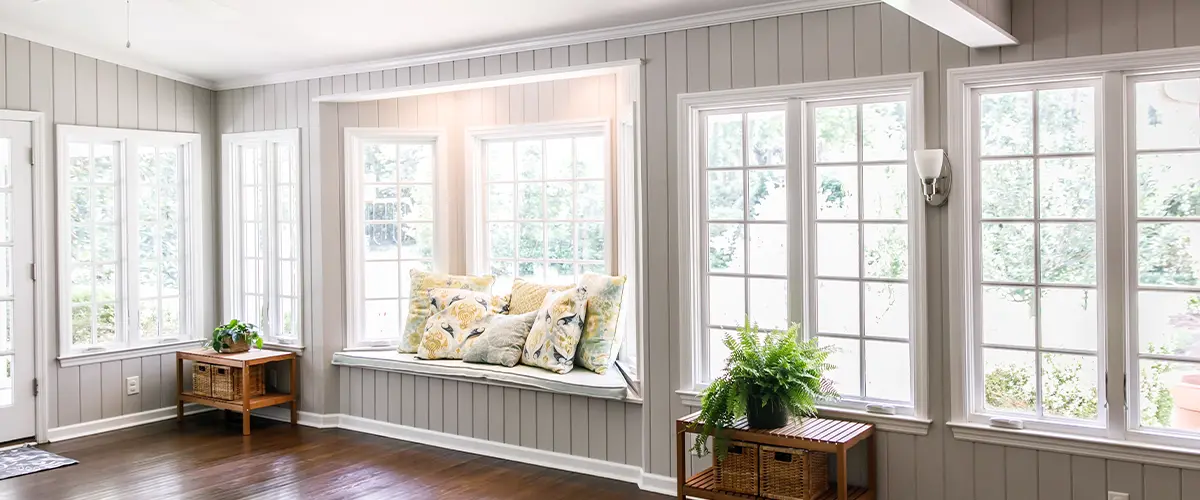When it comes to choosing windows for hot climates, the goal is to keep the heat out and the cool air in. You don’t want your home turning into an oven during those scorching summer months.
So, what are the best types of windows for staying cool and comfy?

1. Low-E Glass Windows
Low-emissivity glass windows are a top choice for hot climates. They have a special coating that reflects heat from the sun while letting in light. This helps to keep your home cooler and reduces the strain on your air conditioner.
2. Double or Triple Glazing
Windows with double or triple glazing are great for hot climates. These windows have two or three layers of glass with a space between them, which acts as insulation. This extra layer helps keep the heat outside and the cool air inside.
3. Tinted Windows
Tinted windows are another effective option. They reduce the amount of sunlight that enters your home, which can help lower indoor temperatures. Just be sure to choose a tint that doesn’t block out too much light.
4. Window Films
If you’re not ready to replace your windows, consider applying window films. These films can reduce heat and glare, making your home more comfortable without the cost of new windows.
5. Shade Screens or Awnings
Adding shade screens or awnings to your windows can make a big difference. They block out direct sunlight, reducing the heat that enters your home. This can be a simple and cost-effective way to improve your home’s energy efficiency.
6. Reflective Coatings
Reflective coatings on windows can help bounce back heat from the sun. They work well in sunny, hot climates by reflecting a significant portion of the sun’s rays away from your home.

Window Styles for Different Climates
When choosing windows, the style you pick can impact both energy efficiency and comfort. Here’s a rundown of popular window styles and how they fare in hot and cold climates:
Casement Windows
Casement windows are hinged on one side and open outward like a door. They offer a tight seal when closed, making them great for both hot and cold climates.
In hot weather, they allow for good ventilation when opened, which helps in cooling down your home. In cold weather, their tight seal helps keep the warmth inside, reducing drafts.
Sliding Windows
Sliding windows slide open horizontally. They’re easy to use and great for wide spaces. However, they don’t seal as tightly as casement windows, which can be a downside in both hot and cold climates.
In hot weather, they might let in more heat, and in cold weather, they can let drafts in. If you choose sliding windows, make sure they’re properly insulated and sealed.
Awning Windows
Awning windows are hinged at the top and open outward. They’re excellent for hot climates because they can be left open during rain without letting water inside. This helps with ventilation and keeping your home cooler.
In cold climates, they also provide a good seal when closed, but you should ensure they’re properly weather-stripped to prevent drafts.
Double-Hung Windows
Double-hung windows have two sashes that slide up and down. They’re versatile and work well in various climates. In hot weather, you can open both sashes to promote airflow.
In cold weather, they can provide a decent seal, but it’s important to check for any gaps or drafts around the sashes.
Maintenance Tips for Your Windows
Keeping your windows in top shape is key to ensuring they perform well and last a long time. Here are some simple maintenance tips:
Regular Cleaning
Clean your windows regularly to keep them looking good and functioning well. Use a mild soap and water solution to clean the glass and avoid harsh chemicals that could damage the window frame. For the frames and sashes, use a damp cloth to wipe away dust and dirt.
Check for Drafts
Periodically check for drafts around your windows, especially during extreme weather. You can do this by feeling for cool or warm air around the edges of the window. If you find any drafts, it might be time to replace or repair weather stripping.
Inspect Seals and Frames
Inspect the seals and frames of your windows for any signs of damage or wear. Look for cracks, gaps, or peeling paint. Address any issues promptly to prevent further damage and to ensure your windows are properly insulated.
Double-hung windows have two sashes that slide up and down. They’re versatile and work well in various climates. In hot weather, you can open both sashes to promote airflow.
In cold weather, they can provide a decent seal, but it’s important to check for any gaps or drafts around the sashes.
FAQs
For hot climates, casement and awning windows are great choices because they provide good ventilation and a tight seal to keep the heat out. Tinted or Low-E glass can also help reduce the amount of heat that enters your home.
Look for windows with a Low-E coating, double or triple glazing, and good insulation properties. Checking for an Energy Star label can also help you determine if your windows meet energy efficiency standards.
Regular maintenance, including cleaning and checking for drafts, should be done at least twice a year. Inspect seals and frames for damage and lubricate moving parts as needed.
Yes, you can improve the efficiency of existing windows by applying window films, adding weather stripping, or installing shade screens. For significant upgrades, consider new energy-efficient windows.
Let Our Window Experts Guide You
Choosing the right windows for your home is essential for comfort and energy efficiency, whether you’re dealing with hot summers or cold winters. By selecting the appropriate window styles and maintaining them properly, you can ensure your home remains cozy and your energy bills stay manageable.
Ready to upgrade your windows for year-round comfort and efficiency?
Contact us today to learn more or to schedule a consultation. Let us help you enhance your home with the perfect window solution! (615) 861-2315
